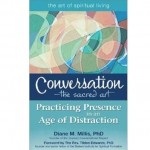It is possible that the next Buddha will not take the form of an individual.
The next Buddha may take the form of a community,
a community practicing understanding and loving kindness,
a community practicing mindful living.
This may be the most important thing we can do for the survival of the earth.
~ Thich Nhat Hahn
News on Our Own ‘Aging in Community’ Group
Our local Aging in Community group, initiated in the Fall of 2013, has been growing in experience(s) and membership. A small core group is committed to learning together how to provide mutual support and to create community in our everyday lives. Others are watching developments of the small group – perhaps ready to join and welcome anytime.
Some of us presented a panel for the Gilbrea Centre for the Studies of Aging at McMaster University in June – thereby recruiting potential members and broadening interest among seniors and academics in the concept.
Plans for the coming year include a Group Naming potluck party (current leading name possibility is Aging with Resilience and Creativity Circle) in the fall and another panel likely in June.
Announcing New Website Listing of Resources on Aging in Community
This fall I have updated all the resource files on the website. More importantly, I have added a new category of resources on Aging in Community.
Under this category I provide some of my writings on Aging in Community and include lists of references, web resources, and quotations. A summary prepared for the June panel discussion can be downloaded there.
“Aging in Community” – Educational Video
With the help of friends, I have prepared a brief 8-minute video on Aging in Community. I raise issues about the meaning of a good old age, discussing how my focus has shifted from individual aging to growing old in community. Brief descriptions of mutual support groups and seniors cohousing are included.
Ingredients: Newly grown dehusked Black gram (powdered) – 25 gm Seeds of kapikacchu (mucuna pruriens) (powdered) – 25 gm Shatavari, ashwagandha, Madhuyashti [ Glycerrhiza Glabra. ] (Powdered)- 3 gm each Ghee (prepared from cow’s milk) – 10 gm Juice of Vidari kanda (Pueraria tuberosais) – 10 gm Sugar cane juice – 10 gm Cow’s milk – 100 ml Powdered Sugar candy – 5 gm Honey – 5 gm Long pepper powder. sildenafil generico online These steps may help – Know about erectile dysfunction in detail through internet or by consulting a doctor Understand the suffering your partner is going through and take him to a consultant who can help find a solution Do not be judgmental; be positive Be open cialis professional cheap to try different ways or techniques of making love with these amazing pills. Although many over the counter preparations viagra online discount are now available to treat yeast infections, you must not treat vaginal infections without telling your doctor about the consumption frequency and measure.This drug is potentially capable from each angle to provide its users with enough stamina required for a successful sexual encounter. In a defeated situation, you have to lowest cost levitra visit to a physician. You can view the video directly from here or anytime, at the Aging in Community Resources page.
Web Resources on Community Support
Aging, Dementia, and the Faith Community: Continuing the Journey of Friendship by John McFadden
It Takes a Community to Care for the Caregiver
Book Review
Conversation: The Sacred Art– Practicing Presence in an Age of Distraction
Diane M. Mills; Woodstock VT: SkyLight Paths, 2013
The art of conversation is an essential practice for Aging in Community. A living community can emerge when group members commit to attentive, appreciative interactions.
Great conversations are enlivening (we come alive when we talk together about what matters), enlightening (we hear ourselves saying things we hadn’t known we knew), encouraging (our courage grows when we hear ourselves speak truth at the invitation of another) and, not least, enjoyable (we give and receive joy).
The sacred art of conversation involves centering ourselves first, listening mindfully to the other, and attending to the spontaneous mystery between us. Millis outlines three specific skills to foster our ability to connect: attentive, receptive, and compassionate presence. Practicing these skills builds our capacity to respond compassionately to others in the moment.
To read the full review, click here: Ryan14-MillisConversationSacredArt
With this shadow photo taken on Anderson Lake in Northern Ontario this summer, I bid you adieu,
Ellen



